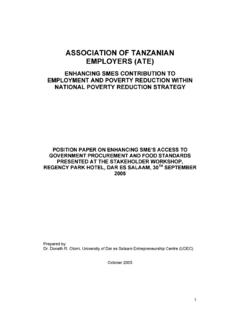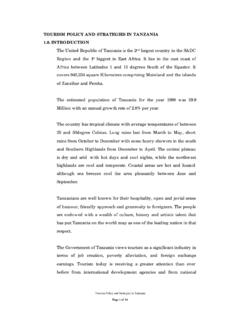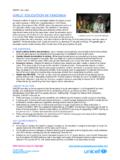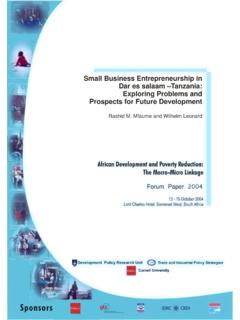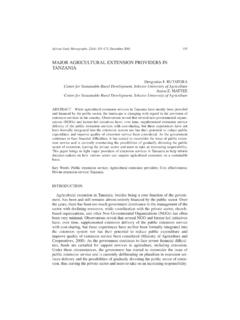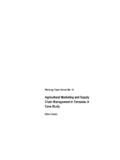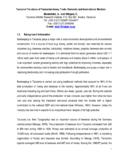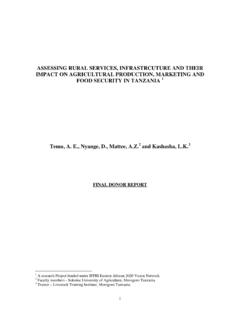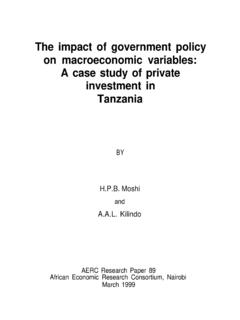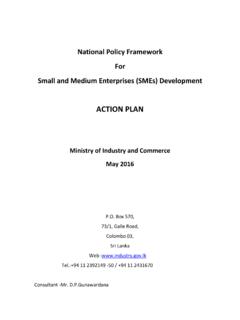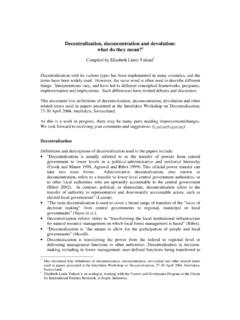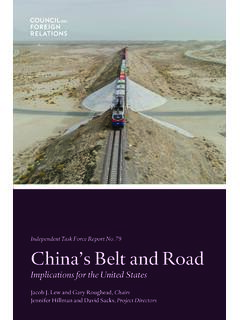Transcription of Improving education in rural areas: Guidance for rural ...
1 Improving education in rural areas: Guidance for rural development specialists Jeanne Moulton For Charles Maguire, The world bank January 2001J. Moulton, rural education , 05/16/01 third draft ii Executive summary Universal basic education is a critical part of rural development. Individuals who have had some education are better farmers and more capable of finding off-farm employment. The rural sector also benefits from the overall development of the national economy and the alleviation of poverty, in which basic education is essential. Yet rural primary schools in low-income countries often suffer because they are remote from the central offices of the ministry of education , which distribute instructional resources, so their quality is poor. In addition, the national schooling model, developed in an urban context, is not so relevant to the rural setting, and rural families cannot afford the direct cost of schooling nor the opportunity cost of having their children away for many hours of the day in low-quality schools.
2 In the past decade, the world bank and other international funding agencies have worked with governments to provide good-quality primary schooling to all children, even those in remote rural areas. During this period, several models of rural schools have been piloted, and educators are learning more about the underlying principles of providing good-quality education in rural areas. The key factors include local voice in what the school offers and how it is governed (often in the form of community schools), recruiting and supporting capable teachers, adapting the curriculum to a rural setting while keeping it within the national system, helping those who cannot afford school to pay for it, and budgeting for the full cost of constructing new schools. The world bank has a mixed record on supporting rural schools. rural primary education is now benefiting, however, from experience with new models supported by the bank .
3 Because it is important to understand the distinctive characteristics of rural settings, to which schools must be responsive, and to support interventions that enhance rural schools and their grounding in a rural environment, education specialists at the bank could benefit from collaboration with their colleagues in rural development. Help educators define what is rural . bank documents reveal that those who plan education projects do not generally look at quantitative or qualitative data that would demarcate rural areas and that would reveal variations within rural areas that are important for supporting rural schools. rural development specialists might help education specialists analyze the rural space, both the physical and social/cultural environment, so that either national or targeted rural education projects take the particular rural environment into account in project design and implementation.
4 School mapping (determining where new schools should be built) is a particular exercise that would benefit from input of individuals that know the rural areas being mapped. Collaborate in the preparation of world bank required planning documents, including the Country Assistance Strategy and the Poverty Reduction Strategy Paper (PRSP). The PRSP, in particular, includes a focus on Community-Driven Development (CDD), which is the process shown to be effective in providing access to those public goods that are within the management capacity of community organizations. The CDD process encourages cross-sectoral activities and provides a procedural opportunity for bank staff and their clients to consider improvements in primary schooling in plans for developing and sustaining the rural space. Make available to schools people and other resources for teaching children about their rural environment, agricultural skills, and other practical skills and knowledge that complements the academic curriculum.
5 Help schools connect children to their environment. Partner on straightforward, well-defined interventions, such as mounting solar-power panels on schools or providing well water to schools. Satisfactory cooperation on visible projects might then point the way to other kinds of collaboration. J. Moulton, rural education , 05/16/01 third draft iii Encourage communities to use the school as a center for education and social activities beyond primary school. Make the school hospitable for adult literacy classes, extension activities, women s groups, community functions, and other activities and events. This not only brings parents into the school, it also helps transform the school into a multi-function learning and meeting center and puts it at the center of the community. The CDD process lends itself to exploring community uses of school facilities.
6 Collaborate to train extension agents and primary school teachers to listen and respond to expressions of needs and problems outside of their own professional setting. Extension agents can learn to deal not only with agriculture and teachers not only with schools, but instead, both can deal with the broader rural space. Promote political support. Effective schools, like other rural institutions, require broad-based support at the local level. Projects in all rural sectors, including education , often have components designed to increase support for their activities. rural development and education specialists might pilot activities that foster local political support for a wide array of development activities, including school improvements as well as other rural development activities. Again, the CDD process provides opportunities for this kind of cross-cultural Moulton, rural education , 05/16/01 third draft ivTable of Contents rural education an The value of basic International investments in The barriers to good-quality rural Successful models of rural What are the critical elements of these models?
7 17 The bank s record in rural Summary and Annex 1. world bank education projects with rural components, Annex 3. Escuela Nueva and Annex 3. J. Moulton, rural education , 05/16/01 third draft 1 Purpose world bank specialists in rural development detect an urban bias behind the negligent state of rural primary schools in low-income countries. Ministries of education , with their limited resources, lack of affinity with rural problems, and pressure from urban power bases fail to give adequate support to rural schools. Yet world bank education projects usually give priority to primary schools in rural areas, especially to schools for rural girls and for children living in poverty. What is behind this apparent contradiction? One explanation is that because most bank projects in basic education are aimed at the entire primary education system, and the reform of education systems and their schools is a long, slow process, educators have only recently begun to learn and share information about what distinguishes rural schools from urban schools and what are the most cost-effective ways of supporting rural schools.
8 The purpose of this paper is to give rural development specialists an overview of basic education in primary schools in rural areas, what is being done to improve it, and what role they can play in Improving it. While rural development specialists should not expect to design primary school components to their projects, they should be able to consider possibilities for including these schools in rural development strategies with an integrated perspective. With a good understanding of the problems facing rural primary schools, models that hold promise for Improving these schools, and the principals that should guide rural education reform, rural development specialists should be able to assess the viability in their own projects of activities that would facilitate improvement of rural schools. We hope that this may lead to collaborative partnerships between the rural Development Family and the Human Development Network that reach where educators alone cannot move.
9 Methodology To pull together the experience of ministries, the world bank , and other funding agencies on basic education in rural areas, we looked at three kinds of data. To review the world bank s experience, we constructed a database on bank basic and primary education projects between 1989 and 1999 that included rural schools in their domain. We reviewed the design documents (SAR or PAD) of about half of these projects to see what the particular problems were in education in rural areas and the strategies proposed to address them. The complete list of primary education projects that include rural areas is listed in Annex 1. To review the experience of other funding agencies, we looked at their available documentation and spoke to selected representatives. For existing analyses, we looked at the research literature on rural education in developing countries and the world bank education Advisory Service sources.
10 We found consistent agreement among analyses on the importance of educating rural children, definitions of the problems facing rural schools, and solutions devised to improve rural schools. We also found some underlying principles, learned through experience, and some still controversial issues. The paper is organized to address these questions: From a global perspective, how does rural basic education compare with urban education ? Why is basic education important to rural development? J. Moulton, rural education , 05/16/01 third draft 2 How do international organizations invest in basic education ? What successes have been achieved in rural basic education ? What strategies are critical to developing effective rural schools? What is the bank s record in supporting rural basic education ? What should be the role of rural development specialists in supporting rural education ?
